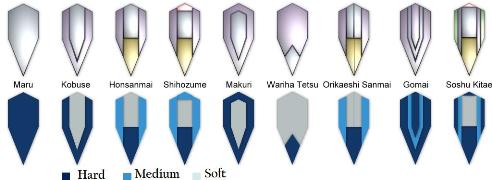Deleted
Deleted Member
Posts: 0
|
Post by Deleted on Jun 20, 2012 6:25:46 GMT
Hello. I am posting this in the Chinese Swords section because that is specifically what I'm wondering about but the question could apply to any sword really. I have seen "Damascus" blades where the lamination lines were very prominent but when I look at photo's of Jians, I have to look very close in order to see the laminations. What are the differences between the two? Are the laminations of the Damascus acid etched to make them more visible? Is it (the visibility) a product of the forging process? Or is it a question of the material? I really like the look of the laminations being very prominent, almost like you could run a fingernail along each lamination. Do Jian sometimes have this feature? Something of what i'm talking about can be seen on the Kun Wu Jian from Enlightenment. Is this feature a matter of price? Is it possible for a $400 sword to have this? Any light that can be shed would be most appreciated. Thanks.
|
|
|
|
Post by Jakeonthekob on Jun 20, 2012 7:42:10 GMT
A really visible forge-folded lamination just means less folds. A harder to see folding pattern means that it has tighter grain (which is usually sought after) though it will be more expensive. The level of polish is also something to consider and will affect whether or not the grain will be hard to see or pop out in the right light.
|
|
|
|
Post by THE_SUPERWEIRDO on Jun 21, 2012 3:26:27 GMT
Based on what I have seen on other discussions, I find that the lamination lines are visible depending on the lamination type. Like a maru laminated sword would have different lines of a sanmai laminated one. Plus how much folds it had (Thanks Jake for the info!) would practically determine how visible the folds are. But I have completely no experience at Chinese swords, so I practically just used my Japanese sword knowledge. :? So, I would trust the guy who owns one.  |
|
|
|
Post by Bushido on Jun 24, 2012 12:16:41 GMT
One thing to take into consideration is what kinds of steel you use for the lamination. The way I'vre heard it, you need "contrast" between two different types of steel to even be able to see the folds. The bigger difference in varbon content, the more visible the folds will be. If you fold say 1060 carbon steel together with more 1060 carbon steel, you will hardly see the folds at all. But if you fold 1045 together with 1095, it will pop out much more. And those mosaic damascus blades you see from time to time that are more or less zebra-colored with black and white stripes are extched to bring out the contrast even more. The different steels react different to the etch based on the carbon content and so the contrast is amplified. Big open mosaic patterns means less folds, a tight grainy pattern means lots of folds (so basically the difference lies in the amount of time spent forging and folding the blade). When it comes to practicality, originally the folding was just a method of distributing the carbon throughout the steel more evenly. At that time you didn't have high quality carbon steel with a uniform distribution troughout the steel, so you had to "rearrange it". One way of doing this was to fold the steel and mix the carbon out. This gave birth to the natural grainy pattern, and tghen people started experimenting with folding and twisting and etching to make very eye-cathing and extravagant blades with beautifully visible patterns in them. Nowadays there really isn't much need for folded steel as the carbon is already uniformely spread throughout the steel (if you're not making powder steel blades, tamahagane etc), it's merelyan aesthetic thing. But it does look really nice, and I can definitely see the appeal which is why my custom chinese jian has folded side panels. You can therefore see a couple of clear lamionation lines where the side panel steel bonds together with the harder steel core, and then the side panels have their own grainy pattern from the folds. You can read more about my sword and look at some pictures here: viewtopic.php?f=6&t=11240Cheers, Anton. |
|
|
|
Post by Bushido on Jun 24, 2012 12:22:35 GMT
Pardon me if I'm wrong, but doesn't maru mean monosteel as per this diagram?  A monosteel blade could of course be forge folded as well, but that'd give more of a damascus pattern grain. Whereas a sanmai laminated blade will have clear lines along the side of the blades where the different steels bond together. As far as I've been taught, there's a difference between grain and lamination lines. Maru blades don't have any lamination lines as they are monosteel, but they can have grain. Laminated blades, sanmai or otherwise, can have both (or they can have lamination lines only if the different panels haven't been folded). |
|

